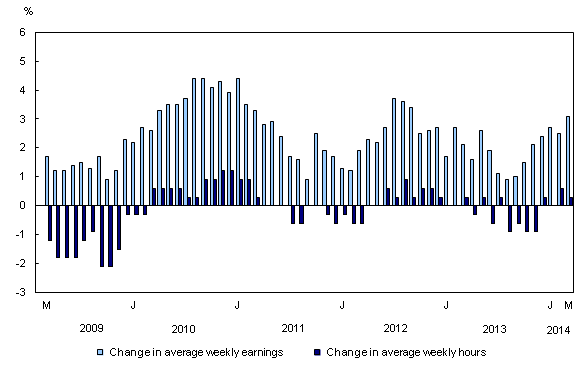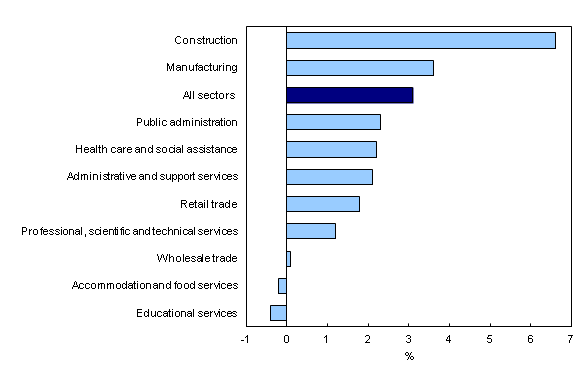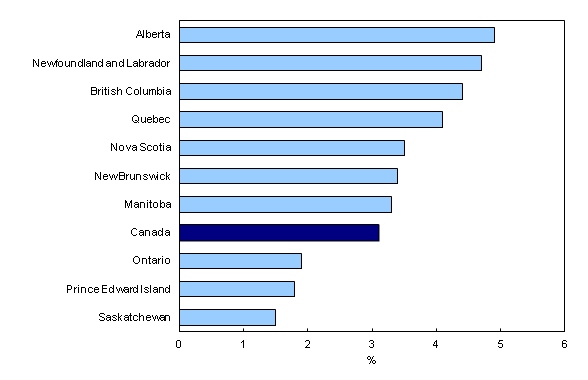Payroll employment, earnings and hours, March 2014
Archived Content
Information identified as archived is provided for reference, research or recordkeeping purposes. It is not subject to the Government of Canada Web Standards and has not been altered or updated since it was archived. Please "contact us" to request a format other than those available.
Released: 2014-05-29
Average weekly earnings of non-farm payroll employees were $933 in March, up 0.7% from the previous month. On a year-over-year basis, weekly earnings increased 3.1%.
The 3.1% increase in weekly earnings during the 12 months to March reflected a number of factors, including wage growth, changes in the composition of employment by industry, occupation and level of job experience as well as average hours worked per week. Non-farm payroll employees worked an average of 33.0 hours per week in March, unchanged from the previous month and up slightly from the average of 32.9 hours observed 12 months earlier.
Average weekly earnings by sector
Year-over-year growth in average weekly earnings outpaced the national average in 2 of the 10 largest industrial sectors, construction and manufacturing.
Compared with 12 months earlier, average weekly earnings in construction grew by 6.6% to $1,215, with all the gains occurring prior to October 2013. Over the 12-month period, gains were spread across all industries in this sector.
In the 12 months to March, average weekly earnings in manufacturing increased by 3.6% to $1,041. The largest year-over-year increases were in food manufacturing and machinery manufacturing.
Average weekly earnings by province
Year-over-year earnings of non-farm payroll employees increased in all provinces. The largest growth was in Alberta, Newfoundland and Labrador, British Columbia and Quebec, while the smallest was in Saskatchewan.
In the 12 months to March, average weekly earnings in Alberta grew by 4.9% to $1,147, with growth spread across most sectors.
In Newfoundland and Labrador, weekly earnings rose 4.7% to $993 in the 12 months to March, with notable growth in professional, scientific and technical services; transportation and warehousing; educational services; and health care and social assistance.
From a recent low of $863 in March 2013, average weekly earnings in British Columbia were up 4.4% to $901 in March 2014. Gains in this province were spread across most sectors.
Weekly earnings in Quebec were up 4.1% to $842 in the 12 months to March, compared with a recent low of $808 in March 2013. All the gains were in the first 2 months of this 12-month period.
In Saskatchewan, average weekly earnings were $961 in March 2013 before dropping to an average of nearly $950 for the rest of 2013. Gains in recent months brought the average up to $976 in March, for a year-over-year increase of 1.5%.
Non-farm payroll employment by sector
Total non-farm payroll employment fell by 45,300 in March, following a 24,200 decline in February. The largest decreases in March were in construction; health care and social assistance; transportation and warehousing; manufacturing; and educational services. At the same time, there was more payroll employment in professional, scientific and technical services; mining, quarrying, and oil and gas extraction; and real estate and rental and leasing.
Despite declines in recent months, the number of non-farm payroll employees was 52,600 or 0.3% higher compared with 12 months earlier.
Mining, quarrying, and oil and gas extraction (+2.3%) posted the highest 12-month growth rate, followed by health and social assistance (+1.7%), accommodation and food services (+1.6%), as well as real estate and rental and leasing (+1.5%). Over the same period, employment declined in manufacturing (-1.8%), utilities (-1.6%) as well as information and cultural industries (-1.1%).
Note to readers
The Survey of Employment, Payrolls and Hours (SEPH) is produced by a combination of a census of payroll deductions, provided by the Canada Revenue Agency, and the Business Payrolls Survey, which collects data from a sample of 15,000 establishments. Its key objective is to provide a monthly portrait of the level of earnings, and the number of jobs and hours worked by detailed industry at the national, provincial and territorial level.
Estimates of average weekly earnings and hours worked are based on a sample and are therefore subject to sampling variability. This analysis focuses on differences between estimates that are statistically significant at the 68% confidence level. Payroll employment estimates are based on a census of administrative data and are not subject to sampling variability.
Statistics Canada also produces employment estimates from its Labour Force Survey (LFS). The LFS is a monthly household survey, the main objective of which is to divide the working-age population into three mutually exclusive groups: the employed (including the self-employed), unemployed and not in the labour force. This survey is the official source for the unemployment rate and collects data on the socio-demographic characteristics of all those in the labour market.
As a result of conceptual and methodological differences, estimates of changes from SEPH and LFS do differ from time to time. However, the trends in the data are quite similar.
Unless otherwise stated, this release presents seasonally adjusted data, which facilitates comparisons by removing the effects of seasonal variations. For more information on seasonal adjustment, see "Seasonal adjustment and identifying economic trends."
Non-farm payroll employment data are for all hourly and salaried employees, as well as the "other employees" category, which includes piece-rate and commission-only employees.
Average weekly hours data are for hourly and salaried employees only and exclude businesses that could not be classified to a North American Industry Classification System (NAICS) code.
All earnings data include overtime pay and exclude businesses that could not be classified to a NAICS code. Earnings data are based on gross taxable payroll before source deductions. Average weekly earnings are derived by dividing total weekly earnings by the number of employees.
With each release, data for the current reference month are subject to revision. Data have been revised for the previous month. Users are encouraged to request and use the most up-to-date data for each month.
A data table is available from the Browse by key resource module of our website under Summary tables.
Data on payroll employment, earnings and hours for April will be released on June 26.
More information about the concepts and use of the Survey of Employment, Payrolls and Hours is available online in The Guide to the Survey of Employment, Payrolls and Hours (Catalogue number72-203-G), from the Browse by key resource module of our website under Publications.
Contact information
For more information, contact us (toll-free 1-800-263-1136; 514-283-8300; infostats@statcan.gc.ca).
To enquire about the concepts, methods or data quality of this release, contact May Roos (613-951-6014; may.roos@statcan.gc.ca), Labour Statistics Division.
- Date modified:




